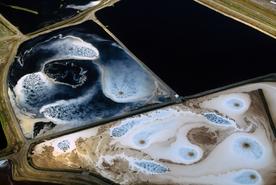
There are four types of lagoons seen in field practice:
- Anaerobic Lagoons - are deep impoundments suited for treating higher strength wastewater including meat processing, dairy, and feed lot wastes. With a depth of 8 - 15 feet, the wastewater separates into layers with a cap of grease and solids forming a barrier to oxygen which allows for true anaerobic microbes to thrive in the deeper regions of the lagoon. Facultative and fermentative anaerobes degrade organics into short chain fatty acids utilized by the methanogenic organaisms. With a sufficient retention time and absence of oxygen, the anaerobic lagoon produces methane and carbon dioxide while removing substantial quantities of BOD/COD.
- Facultative Lagoons - are used to treat moderate strength wastewater such as that found in domestic waste. Oxygen for aerobic microbes is provided by wave action and algae growth. Further down in the lagoon, activity transitions to microaerophilic (D.O. <0.25 mg/L), and finally to the true anaerobic zone on the bottom. Designed based on organic (BOD) loading, lagoons should receive between 13 - 70 lbs/acre/day with a residence time of 20 - 180 days based on location and average temperatures.
- Aerated Lagoons - a common modification of facultative lagoons includes the addition of mechanical aeration. In this system there is less seasonal variation in treatment efficiency, and the BOD loadings can be increased over facultative lagoons. Treatment time (given by hydraulic detention time) is also reduced. Aerated lagoons are commonly used to treat pulp & paper and municipal wastewater where a facultative system is either too large or cannot adequately meet treatment needs. BOD removal in lagoon systems can be upwards of 95%.
- Polishing Ponds - are a low loading lagoon found at the end of more aggressive biological treatment. Designed to remove solids by gravity separation, a polishing pond can also remove some of the remaining BOD while also allowing for ammonia removal (nitrification). Polishing ponds are often designed for a BOD loading of 15 - 25 lbs/acre/day with a retention time of 10 - 20 days. UV light from the sun also works to lower fecal counts in wastewater.

 RSS Feed
RSS Feed